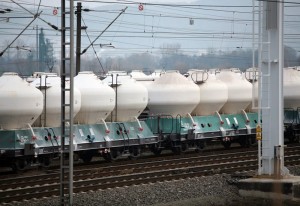A plan to increase mobility and reduce emissions was announced by the European Commission in 2011. This is 2050 Roadmap that was presented as “a competitive transport system to increase mobility, remove the main obstacles in key areas and boost growth and employment”. It also involves a reduction in atmospheric pollution.
However, the EU White Paper has first set an intermediate goal (Directive 2012/34/EU) to be met before this date with a purpose of having one single space for European transport that will require a transformation of the current system in place, for the changeover of 30% of road transport for distances greater than 300 kilometres to other means of transport (such as rail or water) by 2030. The aim is for this percentage to rise to 50% by 2050.
And this begs the question: is this transport changeover actually being met Europe and in Spain in particular? According to data from the European Statistical Office (Eurostat), Spain is lagging behind, in 24th place of a total of 28, at 4.6% compared to the EU average of 17.8%. This is also ratified by the National Commission on Markets and Competition in its Market Supervision report on freight rail transport (published in December 2017 with data from 2016). Meanwhile, Latvia ranks highest in Europe, at 60.4% as well as Germany at 23.5%.
Where the sector stands in Spain
The CNMC report highlights that in Spain, 70.6% of all freight is transported (measured in tons net) by road and 27.9% by boat. Only 1.4% is transported by rail. All of this despite the 11,700 km rail network available for freight train transport.
Despite a 3.5% decrease in operating income (about 331 million euros) (due mainly to the fall in RENFE freight activity by 8.5% in 2016, despite alternative enterprises increasing their total income by 9%), the main freight rail transport productivity indicators went up, with a reduction of costs (average cost per ton net up to 9.7 euros and net t.km net up to 0.023). The CNMC therefore concluded that rail was more competitive compared to in 2015.
Among those to analyse this issue was the Applied Economics Study Foundation (FEDEA) in its report entitled The Future of Freight Transport in Spain that highlights the fact that only 5% of goods are transported by rail in Spain and that goes as far as proposing reforms to improve competition in the sector as well as lowering its costs.
Rolling highways
This concern was also held by the Ministry of Public Works, that presented the Rail Freight Transport Scheme 2017-2023 at the end of last year, which includes a series of measures to promote this mode of transport. It highlighted the lack of costs associated with pollution, accidents, congestion or noise to our society as a whole, which led to a total saving of 428.97 million euros in 2016.
Among these measures is the development of rolling highways. One key event is the launch of two calls for tenders relating to the establishment of rolling highway services along the Atlantic and Mediterranean corridor, presented this March by the Spanish Minister for Internal Development, Iñigo de la Serna and Elisabeth Borne, the French Minister of Transport.
This signals the official launch of the tendering process for the selection of the company to be in charge of these rolling highways (with the deadline ending on 16 July), allowing the transport of semi-trailers by rail. And the reason? The large volume of truck traffic along the two corridors, on the borders of the Perthus and Biriatou.
The two states wish for this to boost the development of the corridors, promote a shift in means of transport and establish and strengthen these services that are alternatives to road freight transport. Both studies particularly relate to the routes that connect the northwest (Vitoria) and east of Spain (Valencia-Murcia) with the north and east of France (Calais/Lille/Metz). They could even be extended via Irún, Bordeaux and Paris, for the Atlantic corridor, or via Barcelona, Avignon and Lyon towards the Mediterranean corridor to allow for a service with the Ile-de-France.
Both Presidents stressed that “this joint position in relation to rolling highways is fully in line with the desire to intensify the cooperation between France and Spain in the field of freight transport by promoting the use of more environmentally friendly modes of transport with the environment. It is also an illustration of the conviction of the Governments that the transport of freight by rail, particularly in these major corridors, is a solution for the future.”


